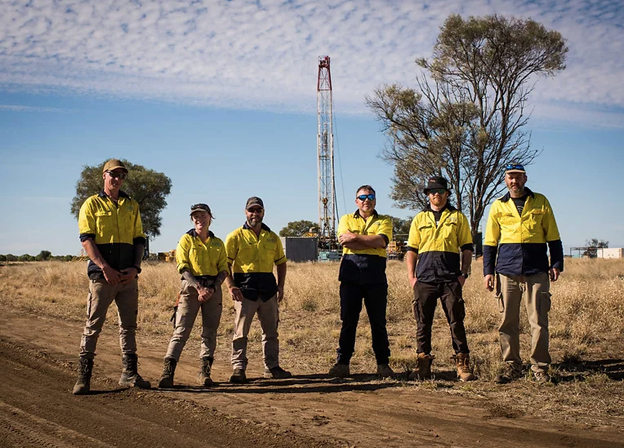
As Australia transitions to renewable energy, there is still a pressing need to optimize its existing gas production fields to meet the growing global energy demand.
Technological advancements in extraction, such as Enhanced Gas Recovery (EGR) injection techniques, are making many production optimization projects across the country more feasible. However, these efforts face significant challenges, including high costs, technical complexities, environmental regulations, regulatory barriers, reservoir variability, and safety risks.
Cameron Grant, Chief Commercial Officer at STRYDE explains: “While onshore fields in Australia are notably smaller compared to offshore basins, they still harbour substantial potential for both domestic and international gas markets. Addressing the challenges related to EGR techniques requires financial prudence, careful planning, technical expertise, and effective risk management to ensure the success and sustainability of enhanced gas recovery projects."
Obtaining work permits involves navigating complex regulatory frameworks, set out by the Federal, State or Territory Governments and industry authorities. This division of regulatory responsibilities can often cause delays and uncertainty for energy projects. In addition to this, permits must address landowner, environmental and social concerns, necessitating thorough environmental impact assessments and community consultations.
Addressing these challenges necessitates collaborative endeavours involving government entities, developers, operators, supply chain stakeholders, environmental advocates, and affected local communities. It's therefore imperative to reach consensus in identifying viable solutions that prioritise environmental preservation while enabling sustainable resource exploitation.
Seismic data has therefore emerged as an affordable, environmentally friendly solution to guide decisions for reservoir optimisation. Thanks to recent technological advancements, companies can now obtain high-definition subsurface images with minimal environmental impact and at a lower cost than previously imaginable.
"This is why Pad3D makes its debut in the Australian market, begins Brendon Mitchell, managing director of seismic solutions company, Oceania Geo.
"Using high-quality seismic to de-risk production optimisation is a no brainer. It costs~AUD$100k-$250k to acquire seismic to de-risk a 3-5sqkm multi-well pad development where horizontal wells are costing $2m+ per well.
“Pad3D is a bespoke production enhancement solution delivered by Oceania Geo, enabled by STRYDE’s cutting-edge seismic technology. The service offers high-resolution seismic data to identify production enhancement opportunities by delivering rapid drill-ready subsurface images for time critical drilling decisions.
“The solution utilises low-impact seismic source and receiver technology that minimises environmental footprint and land disruption which is key in helping obtain your permit to work and getting access to the land you want to survey.”
“At the heart of the new offering lies the STRYDE Node™, the smallest and most cost-effective seismic sensor on the market today. This compact, wireless technology is purposefully engineered for deployment in any land setting, enabling companies to rapidly survey areas with existing infrastructure while minimising land disturbance. This approach facilitates the creation of high-resolution subsurface images required to make informed production optimisation decisions,” added Grant.
Mitchell adds, “Until recently, sensitive environments, constrained by cultural heritage regulations or limited land access, created challenges in obtaining seismic data, resulting in sparse acquisition. This led to irregular and limited geometries, along with added processing complexities and interpretation difficulties.”
By deploying a greater number of receiver devices, at a comparable cost to traditional surveys, it becomes possible to achieve denser seismic coverage with a reduced environmental footprint. This approach eliminates blind spots, expediting the process and enhancing the accuracy of subsurface images. It provides the ability to map challenging shale, coal, and sand layers in the type of complex operational and access conditions often found in the coal seam gas fields across Queensland and unconventional plays in other basins across Australia.
Pad3D was recently piloted by Oceania Geo in collaboration with STRYDE, and Earth Signal Processing for Galilee Energy, where the solution was deployed to demonstrate the viability of acquiring small footprint 3D seismic surveys, using lower cost and lower environmental impact technology for well planning and field optimisation in Australia.
With a focus on delivering structural and stratigraphic certainty via 3D imaging, the project aimed for swift execution to align with planning and pad development schedules while mitigating environmental and cultural heritage disruptions and navigating existing infrastructure. Reducing health, safety, and environmental (HSE) risks was therefore paramount, and this reduction was achieved through smaller crews, scaled equipment, and shortened operation times.

The results speak for themselves:
- Field operations: completed in seven days with six-person crew working 400 hours, with zero incidents.
- Vehicles: two 4x4s, one ATV, one tractor and one bobcat were onsite each day.
- Receiver spacing: 800+ STRYDE Nodes™ deployed per day with a two person crew at 15m spacing. ⁻4935 Live receiver patch – 75m RL x 15m RP
- Source operations: two weight drop source types were used – the WD1400 (which is custom designed by Oceania Geo) and the GPEG500, designed for superior shallow and deep imaging. 800+ source points were shot per day per source at 15m spacing. ⁻2415 Source Points – 150m SL x 15m SP
- Fast-track processing: a fast-track volume was delivered just seven days from last node harvest (fast track volumes are useful for identifying immediate drilling targets, evaluating initial exploration results, or making early project decisions. They provide a preliminary view of the subsurface and can help expedite exploration or development activities).
Mitchell concluded: “The final data resolution surpassed expectations, staying comfortably within budget constraints, and successfully navigated the intricacies of an innovative yet technically complex basin design.
“Using STRYDE's nodes for the Pad3D solution has been instrumental in empowering this project. The success is evident in the results we achieved in the pilot project for Galilee Energy, and we look forward to deploying the solution to help more companies maximise hydrocarbon recovery within their existing fields."
In addition to oil and gas developments, STRYDE and Oceania Geo have also opened new exploration opportunities for the renewables sector across Australia, such as mining and geothermal.
KeyFacts Energy Industry Directory: STRYDE l KeyFacts Energy: Seismic Acquisition News
 KEYFACT Energy
KEYFACT Energy